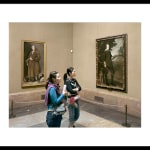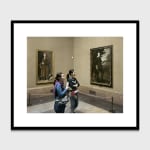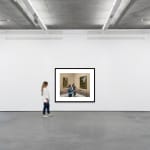Thomas Struth Geldern, Germany, b. 1954
-
 Photo by Rineke Dijkstra, Courtesy of Schirmer/Mosel
Photo by Rineke Dijkstra, Courtesy of Schirmer/Mosel -
Thomas Struth is an acclaimed German photographer whose work examines the ways we experience and inhabit the world — from urban environments and cultural institutions to natural and technological landscapes.
Lives and works in Berlin, Germany
Trained at the Kunstakademie Düsseldorf, he initially studied painting before joining the photography class of Bernd and Hilla Becher, whose conceptual rigor deeply influenced his artistic approach.
Struth first became known in the late 1970s for his black-and-white cityscapes of Düsseldorf, New York, and other cities. These carefully composed images, often devoid of people, capture the quiet order of urban structures and reflect on the relationship between public space and human presence.
In the 1980s, Struth turned to color photography and began the Museum Photographs — a series that remains central to his oeuvre. These large-format works depict visitors standing before famous paintings in institutions such as the Prado, the Louvre, or the Art Institute of Chicago. In these scenes, the act of looking itself becomes the subject: viewers and artworks merge into a single image of contemplation, questioning how culture is seen, preserved, and shared.
Alongside the museum series, Struth produced intimate family portraits and later expanded his focus to include dense jungles, vast industrial sites, and high-tech laboratories. Despite their different subjects, his works share a consistent interest in observation — in how human vision structures understanding of both nature and culture.
Struth’s work has been presented in major exhibitions at the Metropolitan Museum of Art (New York), Kunsthalle Bern, Museo del Prado (Madrid), and Kunsthaus Zürich. His photographs are held in the collections of The Museum of Modern Art (MoMA), Solomon R. Guggenheim Museum, Tate Modern, Centre Pompidou, and the 21st Century Museum of Contemporary Art.
-
WorksOpen a larger version of the following image in a popup:

Installation view 'Thomas Struth. Making Time' Galerie Max Hetzler. Berlin-Mitte, 24 March – 21 April 2007
Thomas Struth Geldern, Germany, b. 1954
Museo Del Prado 2, 2005C-Print142 x 178,7 cm.
(180 x 214,7 cm, framed)
50,9 x 70,3 in.
(70,8 x 84,5 in. framed)Edition 2 of 10Further images
Thomas Struth’s Museum Photographs series examines the complex relationship between art, its audience, and the museum as an institution. His works serve both as an homage to the enduring power...Thomas Struth’s Museum Photographs series examines the complex relationship between art, its audience, and the museum as an institution. His works serve both as an homage to the enduring power of masterpieces and as a critical reflection on their contemporary reception. Struth merges photography, art history, and appropriation, transforming the museum space into an independent artistic investigation.
In Museo del Prado (2005), Struth captures visitors standing before Velázquez’s Las Meninas, one of the most analyzed paintings in Western art. The image is both a study of spectatorship and a conceptual dialogue on the act of viewing itself. Resonating with the methodical precision of Bernd and Hilla Becher and the staged accuracy of Gregory Crewdson and Candida Höfer, the photograph reframes the museum experience as a moment of contemplation, questioning how audiences navigate the tension between historical significance and personal encounter.
“The idea behind the museum photographs was to retrieve masterpieces from the fate of fame, to recover them from their status as iconic paintings, to remind us that these were works which were created in a contemporary moment, by artists who had everyday lives. In essence, I wanted to bring together the time of the picture and the time of the viewer.”
– Thomas Struth








